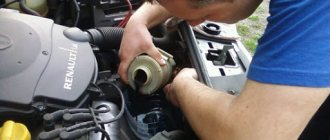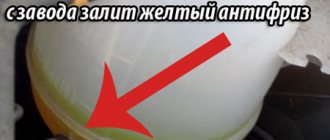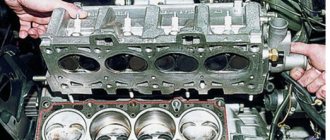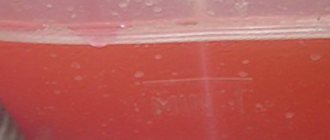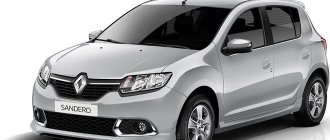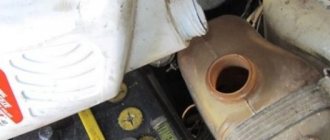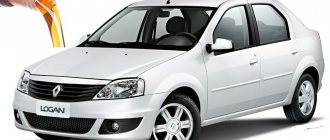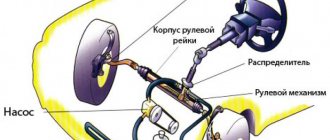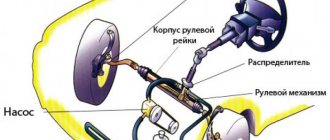As you know, antifreeze (coolants) are necessary for the cooling system to operate any vehicle. They perform the function of cooling the engine and help prevent it from overheating. Today we will tell you how green antifreeze differs from Tosol and what are the characteristics of these liquids.
If you know the difference between liquids of different colors, but are not familiar with what technical characteristics correspond to green refrigerants, then we will tell you about it. One way or another, green antifreeze is a type of coolant, and this concentrate has recently become increasingly popular among domestic motorists.
Filling coolant into the expansion tank
What is the difference between antifreeze and antifreeze?
The concepts of “antifreeze” and “antifreeze” are often confused by car enthusiasts. However, many are sure that this is the same product. But is it? Let's consider each of them separately:
Definition:
- Antifreeze is a general name for cooling compounds, regardless of their color, series and year of manufacture.
- Antifreeze is one of the types of antifreeze that was produced in the Soviet Union. Due to the lack of competition in the market, the term took root among domestic car enthusiasts and became a household name. In fact, “TOSOL” has its own meaning: “Technology of organic synthesis of a separate laboratory.”
Performance characteristics:
- Antifreeze is a substance that provides reliable protection of walls from corrosion without affecting heat transfer. The advantages of the coolant are that it does not lose quality even after 250 thousand kilometers. In addition, the composition uses organic salts, which eliminate the appearance of sediment. The boiling point of antifreeze is 115 degrees Celsius. In practice, the average service life of such a coolant is two years or 100,000 km.
- Antifreeze also forms protection on metal walls. The disadvantage is that the thickness of the film formed is about 0.5 mm, due to which heat transfer is minimal. The result is increased fuel consumption and rapid engine wear. To avoid problems, it is recommended to change antifreeze after 35-40 thousand kilometers. Otherwise it becomes useless. Another drawback is the presence of inorganic salts (silicates, phosphates) in the composition, which over time give sediment or acquire a gel-like state. As a result, the radiator becomes clogged and the entire system requires cleaning.
Antifreeze marking
Coolant has long been known to most drivers. In addition to the familiar markings informing about the freezing temperature of antifreeze, there is also a letter code. This separation makes it possible to obtain more complete information about the composition of the coolant. There are only three types of such designation:
- A – the coolant is completely ready to be poured into the car and does not require changes in its composition;
- M – modernized composition which includes inhibitors that prevent rust;
- K is a concentrate from which coolant is independently prepared by adding distilled water.
It is after this marking that the freezing temperature, purpose and composition are indicated. This designation goes against the requirements of GOST 28084-89, which only allows marking of the finished solution or concentrate. Consequently, antifreeze manufactured according to these requirements does not have the “M” category in its name. The use of specifications in production, on the contrary, does not prohibit such designation.
Main differences
In conclusion, it is worth summarizing the differences between antifreeze and antifreeze:
- Antifreeze is a brand of antifreeze, and antifreeze itself is a general name for all coolants.
- Antifreeze contains inorganic salts, and antifreeze contains organic salts.
- The service life of antifreeze is no more than 40 thousand kilometers, while antifreeze can last 200-250 thousand kilometers.
- Antifreeze guarantees protection on the walls equal to 0.5 mm, which impairs heat transfer. As for the “competitor,” it leaves protection only in weak areas where corrosion occurs.
- Antifreeze can withstand temperatures up to 115 degrees Celsius and does not boil, while antifreeze is less resistant to high temperatures.
Don't skimp on coolant
If you only use your wallet to choose a certain coolant, then there is a good risk of running into a counterfeit or low-quality antifreeze. Mixtures of water and monoethylene glycol are already relatively expensive, not to mention the necessary additives, which cost manufacturers millions of dollars to develop. Therefore, instead of proper alcohol, especially enterprising individuals prefer to use solutions with glycerin and methanol. The cocktail is quite dangerous.
In this case, the antifreeze itself is obtained thanks to a mixture of water and glycerin, but since the latter is quite viscous, it is diluted with methanol. In addition to its toxicity, this type of alcohol is also known for the fact that it begins to boil already at 65 degrees and completely boils away at 95, that is, at the operating temperature of the engine.
Consequences of using low-quality coolant
As a result, what will circulate in the cooling system will be something completely different from what was poured in, and this liquid will not only greatly contribute to the formation of corrosion (it contains no additives), but will also complicate the operation of the cooling system.
Unfortunately, it is almost impossible to protect yourself 100% from buying a fake coolant.
In which cars should I use antifreeze, and where should I use antifreeze?
Against the background of the considered features of different types of coolants, the question arises of what is recommended to be used and in what case.
The first thing you should focus on when choosing is the make of the car and the manufacturer’s recommendations. The developers specify in the vehicle manual which consumables are best to use.
But these are only recommendations. In practice, the car enthusiast takes responsibility for the choice onto his own shoulders.
So which is better? Please note the following points:
- Antifreeze can be used on old domestic cars of the VAZ, Moskvich and other brands. For foreign cars, high-quality antifreeze is more suitable (reasons are described below).
- The use of antifreeze leads to a decrease in power, increased fuel consumption and rapid engine wear.
- Antifreeze is more loyal to aluminum engine elements. If you use antifreeze in cars with a radiator made of this metal, you will soon need to purchase a new unit.
- When using antifreeze, the service life of the water pump is reduced, the radiator and thermostat become dirty faster.
- Antifreeze does not have a detrimental effect on the rubber and plastic elements of the cooling system, which cannot be said about its “competitor”.
Also read - Is it possible to mix antifreeze of different colors, brands and manufacturers in a car.
The effect of antifreeze on the cooling system
Antifreeze combines well with all refrigerants that have mineral additives. This feature allows the use of any domestic coolants, as well as imported analogues designated G11. With the correct density, the corrosive effect will be minimal, but a decrease in such indicators will lead to rapid contamination of the antifreeze from contact with metal parts.
Strong heating is not capable of harming the coolant, but has a detrimental effect on structural elements. Thus, softening of the rubber pipes can lead to leakage of antifreeze, which will require the need to replenish the lost volume. It should be remembered that pouring pure concentrate is strictly prohibited, and such actions can freeze the engine.
What is the difference between different colors of antifreeze?
What is the difference between antifreeze of blue, green, red colors and brands G11 and G12?
To understand the question of what kind of coolant can be filled, and whether mixing them is allowed, it is worth knowing the features of antifreeze types G11 and G12.
Here's what you need to know:
G11.
Inorganic antifreezes are called glycol. The liquid base contains corrosion inhibitors that form a protective film on the inside of the engine elements.
Such additives are useful in cases where the coolant comes into contact with non-ferrous metals.
If there is no protective film on the surface, then the metal is destroyed due to the action of the glycol base.
G11 compounds last for 2-3 years, after which they require replacement.
The first representative of such antifreeze was a coolant called VW coolant G11 (manufactured by Volkswagen).
At the present stage, the company produces “hybrid” coolants under this brand, which are produced according to the following specification - VW TL 774-C.
As for other manufacturers, they follow the path of the founder, but it is not always possible to strictly follow the stated requirements.
Thus, the original G11 antifreeze does not contain phosphates, amines or borates.
As for G11 coolants from other manufacturers, they usually contain these additives. The color of the products is most often green.
G12.
Coolants that belong to the category of carboxylate antifreeze.
The already mentioned Volkswagen company previously released the product VW coolant G 12, after which it developed a specification corresponding to the new coolant (its name is VW TL 774-D).
Unlike the G11 discussed above, the twelfth type has a different effect on the motor.
It is no secret that modern power units are made without the use of copper and brass, and the main sources are steel and aluminum.
During operation, corrosive films are created on the surface of these metals, which lead to gradual destruction of engine parts.
Additives in G12 eliminate the appearance of such deposits. The new technology used in the production process is called Long Life. The advantage is that the coolant lasts longer.
But you can completely switch to a new composition only if there are no non-ferrous metals in the engine. Otherwise, G12 additives will destroy the surface.
The color G12 is usually red (less often yellow).
Green or red. What does the color say?
Coolant of green and red color is most often found on our market. And it is precisely this criterion that motorists sometimes rely on, which is a rather serious mistake. After all, in fact, the shade of antifreeze only tells what kind of dye is used in the mixture, and has nothing to do with its composition.
On the shelves you can find both the same mixtures in different colors, and completely incompatible products, colored the same.
In addition to the green and red coolants common in Kazakhstan, yellow, orange, pink, red, blue-green and blue liquids can be found in production. The same TOSOL belongs to the latter.
Is it possible to mix antifreeze and antifreeze?
Is it possible to mix antifreeze and antifreeze, coolant classes G11 and G12, is it worth flushing the engine after that?
You can find conflicting information on various forums, some say you can mix, others not. Some started having problems after mixing, while for other car owners everything was fine.
Before answering the question of whether mixing different types of coolants is allowed, we highlight the following points:
- It is prohibited to rely on color when considering whether to mix coolant or not. There is no guarantee that the manufacturer followed the rules. Most often, the coolant shade is chosen not based on classification, but to attract customers, for advertising purposes, or to facilitate troubleshooting.
- It is allowed to add the same type of antifreeze to the system. So, if G11 is already present in the cooling system, then it is worth adding it. If G12, then it is recommended to fill it with G12.
- When mixing, it is worth considering the composition of the consumable material and the type of additives. Each manufacturer adds a specific set of additives to its product - anti-foam, anti-corrosion and others. Today, there are dozens of types of additives, which complicates the mixing of certain compounds. If you thoughtlessly pour coolant into the system, you can get a “mix” of additives that will not help the engine, but will ruin it.
- It is prohibited to mix antifreeze with antifreeze due to the different composition. Thus, domestic coolants have an aggressive effect on the cooling system due to the presence of silicate in the composition. As for antifreeze, it does not contain this element, but there is a wide range of other additives.
- It is forbidden to mix antifreezes that are part of the silicate-free group.
When replacing one element with another, it is recommended to flush the cooling system using a special composition. If this is not done, the metal elements of the engine will quickly rust.
In addition, sediment accumulates in the system, clogging the channels and impairing the beneficial properties of the coolant. In this case, mixing is allowed if the liquids have an identical composition but a different color.
Composition and main properties
The composition of antifreeze includes water and dihydric alcohol. In addition to these substances, companies add various additives. Without the use of additives, a pure mixture of alcohol and water will destroy the engine inside in a few months, corrode the radiator, and to prevent this from happening, manufacturers use:
- Corrosion inhibitors.
- Anti-cavitation elements.
- Antifoaming agents.
- Dyes.
Each additive has individual properties, for example, inhibitors create a protective film on engine components, which prevents alcohol from destroying the metal, dyes are used to determine possible leaks, and other substances reduce the destructive effect when the coolant boils.
According to GOST, there are 3 types of antifreeze:
- OZh-K – concentrate.
- OJ-40.
- OZH-65.
Each species differs in its freezing temperature. The main difference between Soviet antifreeze and foreign antifreeze is the quantity and quality of additives, which increase the service life of the engine and radiator. Foreign samples contain about 40 additives, while domestic liquids contain about 10 types. In addition, during production, foreign types use three times more quality parameters.
For a standard liquid, the freezing point is -40 degrees. In European countries, it is customary to use concentrates, so they are diluted with distilled water in different ratios, based on weather conditions and other characteristics. It is recommended to change the fluid every 30-50 thousand km. Depending on the quality. Over the years, alkalinity decreases, foaming and corrosion of metals begin.
What types of product can be mixed
You can be sure that mixing different-colored products will not lead to negative consequences only if the added liquid completely matches the class that is already poured into the system. Nothing bad will happen if the antifreezes do not match in color, but belong to the same category (for example, both are carboxylate).
There are special compatibility tables from which you can accurately determine which types of liquids can be mixed. So, if the system contains G11 class antifreeze, you can add any refrigerant except G12 if necessary. Accordingly, G11 cannot be added to G12. But a lobride product like G13 is compatible only with similar class products or G12++.
What to choose
Often, novice car owners try to purchase coolant based only on its color. This is not entirely correct. It is best to focus on classes. This is the only way to acquire true, proven quality. And if you focus on which antifreeze is better in color, you can buy regular antifreeze instead of the G11 product under the guise of a quality product. And again, you need to look at the class of coolant for a particular car, as well as the material from which the radiator is made. Only after this do we pay attention to the colors of the liquid. As for a quality product, you can pay attention to Sintek products. Here you can choose by color. And for those who don’t know what color Sintek antifreeze comes in, let’s say - all the colors described above.
All motorists (and, of course, not only them) are well aware that antifreeze is a liquid that protects the power unit from overheating, which boils only at temperatures significantly exceeding +100 ° C, and freezes at very low temperatures (usually - -38 °C and below). If relatively recently in Russia there was, in fact, only one type of it - TOSOL, which has a blue color, now red and green liquids have appeared and are widely used. Accordingly, car owners have a completely logical question: what is the difference between red, green and blue antifreeze? Let's try to give a detailed and detailed answer to it.
VW classification
In the post-Soviet space, as well as on the European continent, the classification of coolants proposed by the Volkswagen concern has been adopted. In accordance with it, all antifreezes belong to one of the groups:
- G11 – products of a blue, blue or green tint. This includes hybrid fluids that are recommended for vehicles manufactured before 1996. These antifreezes contain phosphates, nitrates, and silicates, so they should be changed at least once every 2 years.
- G12. These products, which typically come in purple, red and pink, belong to the carboxylate subgroup. They do not contain silicates, and the additive package is balanced.
- G12+ and G12++. Antifreeze with this marking is colored pink. They are characterized by high efficiency and durability.
- G13 is an orange or yellow product, completely environmentally friendly and designed to work in extreme conditions.
You may be interested in: Antifreeze G13 yellow: composition, characteristics
What types of antifreeze exist today?
The world of auto chemicals is represented today by several groups: G11, G12, G 12+, G13. They differ in their technical characteristics and are available in different colors. Let's take a closer look at each of the chemical products.
Antifreeze
Even at the time of the release of the first Zhiguli cars, this product first appeared and immediately found wide application in practice. Imagine that until now, drivers used plain water to cool their engines. It was necessary to drain it completely in the evening on winter evenings, and refill it in the morning.
Such labor-intensive work gave engineers the idea of creating a liquid that would not freeze at zero temperatures and would be suitable for use in the northern regions of the country. That’s when the first antifreeze A 40 appeared, which significantly eased the lot of amateur drivers and brought significant relief to the work of professionals.
Antifreeze had a blue color or was colorless; in this form it is still available and is the most budget option for a number of domestic cars of the GAZ, UAZ, VAZ brands. Antifreeze, as a rule, is not suitable for foreign cars, so owners of foreign cars use other coolants.
Antifreeze G11
An imported product with a green color. Its characteristics are similar to antifreeze. Firstly, it is the cheapest among foreign analogues, and secondly, in its chemical composition it is very similar to our antifreeze. It also contains ethylene glycol, water and a number of elements of chemical and organic properties: phosphates, borates, carboxylic acid, which protects against corrosion.
- This antifreeze was widely used in inexpensive Korean-made cars in the early 2000s. Among the negative qualities of the product, one can highlight its short service life: up to 3 years, sedimentation. As soon as you see green flakes in the expansion tank, this is a sign that the antifreeze has become obsolete.
- There are also antifreezes G11+ and G1++, which have a green or yellow color, but the difference between them and G 11 is small, they contain a little more carboxylic acid and the price is a little higher.
Determining the quality of antifreeze
Although counterfeiting antifreeze due to its low price is not entirely profitable, such cases are far from an exception. The first thing you should pay attention to is the color. The liquid must be blue, and this color cannot affect its transparency. Brand A-65 is red, but its specific temperature conditions make it less popular. The manufacturer's containers always have a good appearance and distortions of the label or a poorly sealed lid are unacceptable.
If you have the slightest doubt, it would be a good idea to ask the seller for a certificate of conformity. Although such a procedure is not mandatory, all manufacturers prefer to voluntarily undergo certification. If such documents do not exist, it is better to forget about the questionable liquid and purchase products from a trusted supplier.
